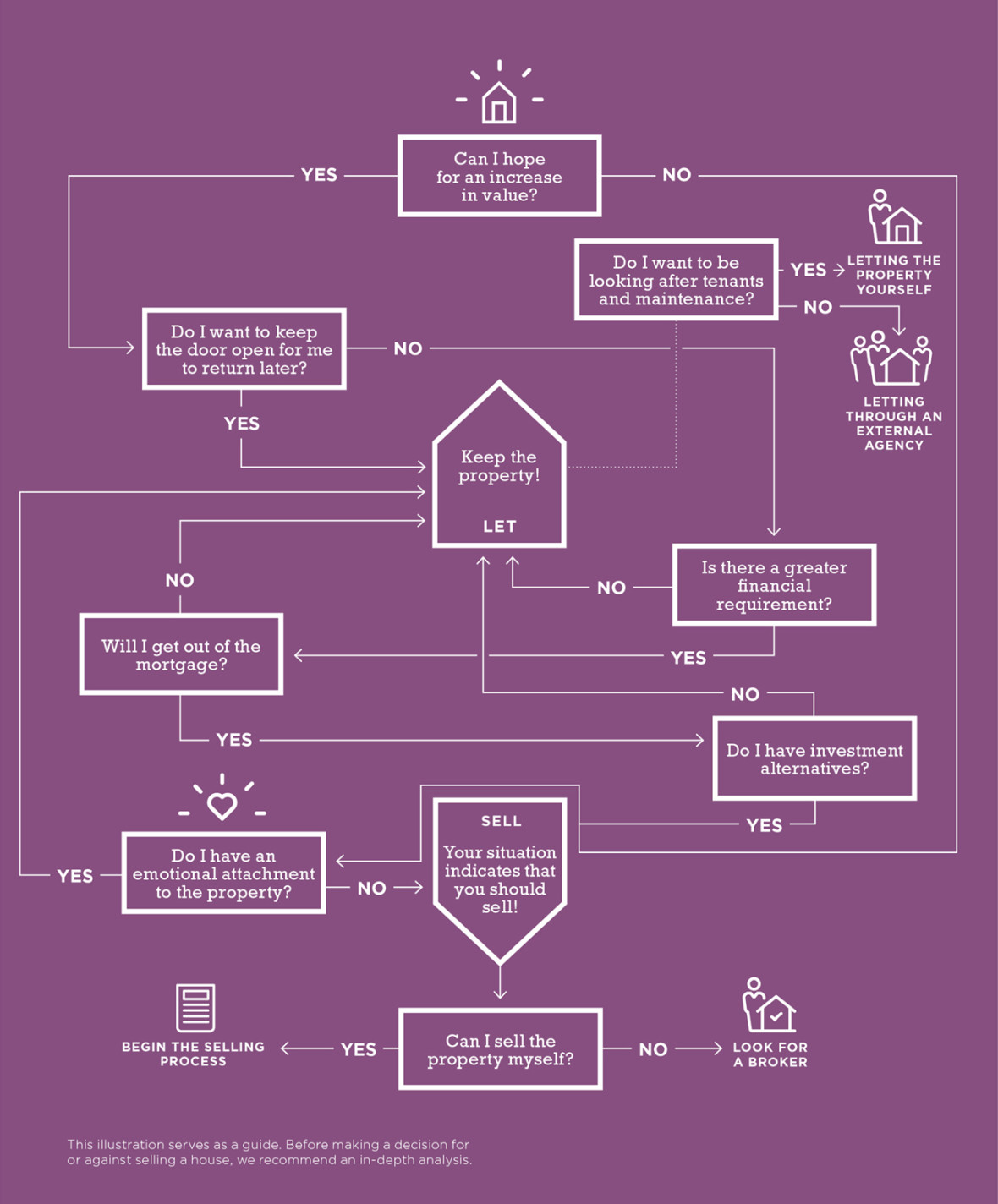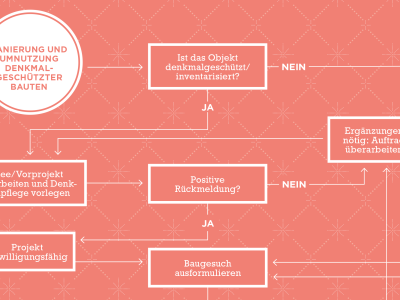
The bliss or burden of letting
Whether intentionally or unexpectedly: taking on the role of landlord brings plenty of food for thought.
Living within one’s own four walls continues to be desirable in Switzerland. The currently favourable financing climate due to low interest rates, attractive supply thanks to brisk construction activity and a deep-seated belief in real estate values as a long-term means to secure savings are all clearing the way to owner-occupied residential property.
According to the Federal Statistical Office, the proportion of homeowners has thus risen from 28.5 per cent to 38.2 per cent of households (2016) since 1970. If things continue like this, the proverbial “country of tenants”, as Switzerland is considered in comparison with Europe as a whole, will slowly but surely become a phenomenon of the past.
Once a house or apartment is occupied, fully furnished and the garden or balcony is planted, its owners rejoice in their happiness. At least for as long as circumstances remain favourable. A simple unforeseen change of employment to some location further afield, for example, can turn that joy into commuter pain. Real-world experience also shows that a separation, such as can occur even in the best families, rapidly turns the disunited couple’s thoughts to a change of residence.
Emotionally attached
Thus, sooner than one might think, an owner-occupied residential property can turn into property that is rented out to a third party. Such a decision might also rear its head many years down the road: by now, the house has become grossly oversized, the maintenance too costly, and in any case it is unsuitable for elderly people. People moving into a condominium were often previously single occupants of their own houses. Sometimes, the passing away of a loved one can force the decision. And yet, many homeowners remain unwilling to sell: they are still too emotionally attached to a property that they may have occupied for a long time.
So – rent it out! Finding a tenant is rarely problematic, especially when the location, size and asking price are right. And after all, regular rental income going into a bank account also has its appeal. But slipping into the role of landlord overnight is not an easy undertaking. It entails dealing with all kinds of questions: contract details and other legal issues, administration, financial and tax aspects. Ancillary costs must be charged according to exact stipulations: tenancy law is inherently complicated and riddled with pitfalls. The effort involved should not be underestimated.
Where there is a lack of capacity and competence to manage the rental property, professionals must be brought onto the scene.
A condominium landlord is responsible for everything within his apartment unit, as well as being the point of contact for the tenant. The condominium owners’ association manages only the property’s shared systems and facilities, not the co-owners’ actual Apartments.
Where there is a lack of capacity and competence to manage the rental property, professionals must be brought onto the scene. This costs money, which reduces the yield but delegates the work and potential hassle to a specialist. The further away a property is located from its owner’s place of residence, the more complicated and time-consuming its management becomes, in turn increasing the necessity for an outside manager. With condominiums, there may already be a company doing this on behalf of other co-owners. This way, experience and synergies can be exploited, while the management cost might also be reduced. It gets more complicated if the rental property is a single-occupancy house rather than an apartment in a building with a janitor who takes care of many things. Maintenance in this case is basically the same as for a rented apartment: minor repairs and basic work are always at the expense of the tenant, while major maintenance costs such as replacing a heating system or defective household appliances must be borne by the landlord.
Who pays for repairs?
It is advisable to discuss with the tenant which repairs will be made at whose expense. This avoids conflicts where a tenant in good faith calls in a specialist, who then proceeds to carry out an expensive repair. Moreover, the statutory mortgage of workmen and contractors (Bauhandwerkerpfandrecht) means that craftsmen may register claims on a house with respect to unpaid invoices, even if the job in question was ordered by its tenant.
The tenant’s obligations regarding maintenance of the garden and surroundings, as well as snow clearance, should also be defined. Likewise liability for possible damage, for structural changes to the property and the question of whether its original condition is to be restored at the end of the lease. Diligence in drawing up a handover protocol at the outset will save unnecessary trouble when the tenant leaves. Templates for residential rental contracts and standard protocols are available from organisations such as the Swiss landlords association (Hauseigentümerverband Schweiz).
Finally, finances must always be borne in mind. Does the rental income generate enough funding to cover taxes, refurbishment and periodic renovations? Is the condominium owners’ collective renewal fund sufficiently well endowed? Should mortgages be paid off or the agreements renewed? Has a former investment property become a risk concentration? Renting can become a burden, but it doesn’t have to be. Yet it’s not a piece of cake in any event.
Tips for new landlords
Every lease starts with the signature of a lease agreement that regulates the rights and obligations of the landlord and his lessee. It may be of limited or open-ended duration and must contain precise information regarding these three points:
- Contracting parties
- The rented property
- Rent charges (net rent plus ancillary costs).
An open-ended agreement may be terminated by either contracting party on the next possible termination date, subject to observance of contractual or statutory periods of notice. Limited-duration agreements terminate on expiry of the agreed term, unless they are renewed.
As a rule, a rent security deposit is agreed as part of the lease, to be paid into an escrow account. This deposit serves the landlord as security for non-payment of rent and/or damage to the rented property. For apartments, the deposit is limited by law to three months’ rent.
There are four variants for settling ancillary costs:
- Payment on account: the tenant pays the landlord a monthly amount in advance. At the end of the accounting period, the landlord calculates an annual statement of account with a comparison of the actual costs incurred.
- Lump sum payment: ancillary costs may be defined as a fixed amount (flat rate) in the lease agreement, in which case the tenant does not receive an annual statement of account.
- Gross rent: this completely dispenses with separation of ancillary costs and the rent compensates all benefits provided by the landlord.
- Direct payments to third parties: costs not included in the net rent are liable for payment by the tenant, who is then responsible for purchasing fuel, for example. This system is frequently used in the rental of single-occupancy dwellings.
Source: Swiss landlords association (HEV Schweiz)
«It makes sense for tenants and landlords to talk»
What is particularly important when renting out your own house or apartment?
The handover protocol documenting the property’s condition. In the case of a single-occupancy dwelling, this will also include an inventory.
What is the recommended lease duration?
For condominiums and single-occupancy dwellings, the custom is to contractually agree a minimum lease period of one year, with three-month statutory notice periods thereafter.
Where do most problems occur?
Ambiguities regarding maintenance and structural changes are regular causes of conflict. In any case, it makes sense for tenants and landlords to talk to each other: good communication saves trouble on both sides.
What must tenants be aware of?
The tenant owes punctual payment of rent and ancillary costs and must take care of the rented property. In a single-occupancy dwelling, he is the sole tenant and bears all ancillary costs himself. House and garden are more work than a rented apartment.
Return on a rented condominium apartment
(calculation example, values in francs)
| Purchase price or fair value | 850,000 |
| Own equity (assumption: 25%) | 212,500 |
| Mortgage | 637,500 |
| Rental income (assumption: 2,100/month) | 25’200 |
| Expenditure (maintenance, ancillary costs, renewal funds, provisions, assumption: 40% of rental income) |
10,080 |
| Mortgage interest of 1.75% | 11’156 |
| Pre-tax net income | 3964 |
| Pre-tax return on own equity | 1.9% |
| Income tax on rental income (marginal tax rate, assumption: 35%, excl. wealth taxes) |
1387 |
| Net income after taxes | 2576 |
| Net income after taxes | 1,21% |
Source: «Beobachter»


